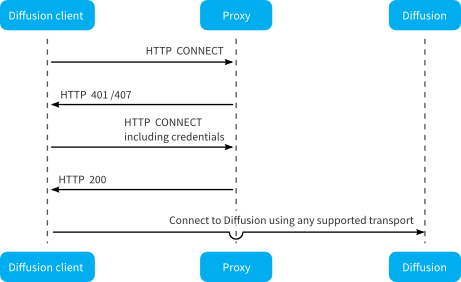Connecting through an HTTP proxy
Clients can connect to the Diffusion™ server through an HTTP proxy by using the HTTP CONNECT verb to create the connection and tunneling any of the supported transports through that connection.

Apple®, Android™, Java™, and .NET clients can connect to the Diffusion server through an HTTP proxy by specifying additional information on connection.
With no authentication at the proxy
When creating your session, add an HTTP proxy to the session by passing in the host and port number of the proxy.
Diffusion.sessions().httpProxy(host, port)
var session = Diffusion.Sessions
.HttpProxy( host, port )
.Open( diffusionUrl );
// Create a mutable session configuration.
PTDiffusionMutableSessionConfiguration *const configuration =
[PTDiffusionMutableSessionConfiguration new];
// Create an unauthenticated HTTP proxy configuration.
PTDiffusionHTTPProxyConfiguration *const proxyConfiguration =
[[PTDiffusionHTTPProxyConfiguration alloc] initWithHost:@"proxy"
port:80];
// Specify the proxy configuration.
configuration.httpProxyConfiguration = proxyConfiguration;
// Open the session, specifying this configuration.
[PTDiffusionSession openWithURL:[NSURL URLWithString:@"wss://push.example.com"]
configuration:configuration
completionHandler:^(PTDiffusionSession *session, NSError *error)
{
// Check error is `nil`, then use session as required.
// Ensure to maintain a strong reference to the session beyond the lifetime
// of this callback, for example by assigning it to an instance variable.
}];
With basic authentication at the proxy
If the proxy requires basic authentication, the client can use the implementation in the Diffusion API to authenticate.
When creating your session, add an HTTP proxy to the session by passing in the host and port number of the proxy and a proxy authentication object that provides the challenge handler for basic authentication.
var clientAuth = Diffusion.ProxyAuthentication.Basic( username, password );
var session = Diffusion.Sessions
.HttpProxy( host, port, clientAuth )
.Open( diffusionUrl );
HTTPProxyAuthentication auth = Diffusion.proxyAuthentication().basic(username, password);
Diffusion.sessions().httpProxy(host, port, auth);
// Create a mutable session configuration.
PTDiffusionMutableSessionConfiguration *const configuration =
[PTDiffusionMutableSessionConfiguration new];
// Create an authentication provider for the HTTP proxy.
const id<PTDiffusionHTTPAuthentication> authentication =
[[PTDiffusionBasicHTTPProxyAuthentication alloc] initWithUsername:@"user"
password:@"pass"];
// Create an authenticated HTTP proxy configuration using the provider.
PTDiffusionHTTPProxyConfiguration *const proxyConfiguration =
[[PTDiffusionHTTPProxyConfiguration alloc] initWithHost:@"proxy"
port:80
authentication:authentication];
// Specify the proxy configuration.
configuration.httpProxyConfiguration = proxyConfiguration;
// Open the session, specifying this configuration.
[PTDiffusionSession openWithURL:[NSURL URLWithString:@"wss://push.example.com"]
configuration:configuration
completionHandler:^(PTDiffusionSession *session, NSError *error)
{
// Check error is `nil`, then use session as required.
// Ensure to maintain a strong reference to the session beyond the lifetime
// of this callback, for example by assigning it to an instance variable.
}];
With another form of authentication at the proxy
If the proxy requires another form of authentication, the client can implement a challenge handler that the client uses to authenticate.
Implement the HTTPProxyAuthentication interface to provide a challenge handler that can handle the type of authentication your proxy uses. When creating your session, add an HTTP proxy to the session by passing in the host and port number of the proxy and a proxy authentication object that provides your challenge handler.